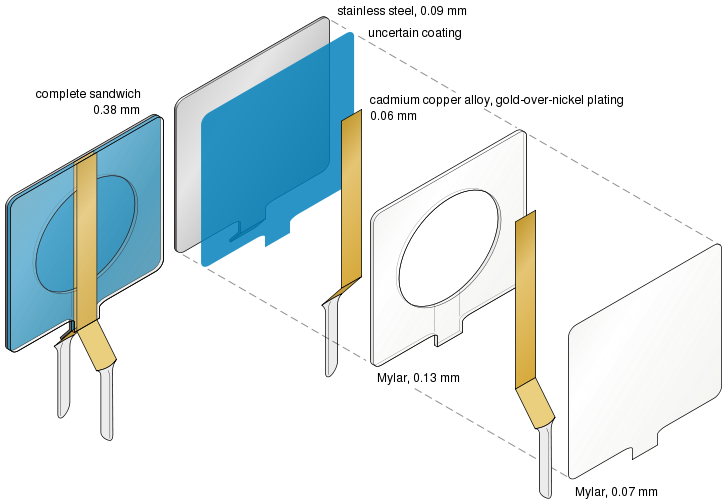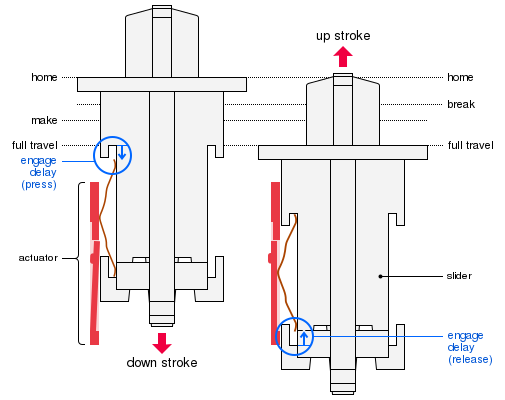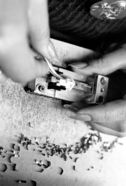Datanetics DC-50 series
| This article requires additional photographic illustration |
| Manufacturer | Datanetics |
|---|---|
| Introduced | 1973 |
| Switch type | Tactile |
| Rated lifetime | 100M |
| Tactile force | 3.0 oz (84 gf) |
| Peak force | ca. 3.8 oz (110 gf) |
| Pretravel | 0.110±0.015″ (2.79±0.38 mm) |
| Total travel | 0.180±0.010″ (4.57±0.25 mm) |
| Switch mount | Fixing screw |
| Patents | US3777090 (1972) |
Datanetics DC-50 series was the first discrete switch module from Datanetics, initiated in 1972 and fully introduced by 1973. The lower profile DC-60 series followed the same year. DC-50 series was still on sale in 1981 side-by-side with DC-60. According to Apple technical documentation from September 1985, "Datanetics keyboards and keyswitches are no longer supported and replacement parts can no longer be ordered"; DC-60 appeared to still be in available in 1990 (used by Fluke in the Y1700 Keyboard), but it appears that DC-50 went end of life by 1985.[1]
Contents
Design
The switch is subtly tactile with a small increase in force of approximately 10 gf directly before actuation, followed by a drop of 0.2 oz (6 gf). The total depth of the tactile curve is around 0.5 mm of travel.
The two defining features of the design are a sealed Mylar-metal sandwich contact assembly, and hysteresis. The hysteresis overlap is 0.040″, or 1.02 mm, which is around twice the length of the tactile curve. The switch contacts are formed as a sealed unit to protect them from contaminants and damage; as Datanetics licensed their diaphragm technology to Futaba, this may account for the Futaba complicated linear switch which is also noted for a sealed contact unit.
The switch shell accepts two contact assembly units, allowing for a DPST arrangement. Support for a latching mechanism was achieved by welding a latching track unit onto the outside of the switch, with a wire connected to the keycap; the switch is otherwise unchanged.
The slider has a large cruciform cross-section, atop which sits a heptagonal or octagonal platform bearing a much smaller cross. The slider is white. The shell is typically black; switches with dark green shells exist[2] but none have been seen in a finished product. The key stem can be either straight or slanted to 12°.
The switch modules are fairly tall, with the shell standing at a fraction under 17 mm high; by comparison, Alps SKCL/SKCM and Cherry MX switches are around 11 mm tall. There are no plate mounting clips; instead, the switches are instead secured using BT self-tapping screws (maximum size #2), for which two screw holes are provided.
The Apple III at one stage used double action DC-50 switches for the arrow keys. These switches (Apple part 705-0012) have yet to be seen, and were not listed in Datanetics brochures.
Contact assembly
The contact assembly in DC-50 is a sealed metal–plastic sandwich. The contact assembly is based on Datanetics elastic diaphragm array, but is not a true membrane system as the contacts are strips of metal instead of traces printed onto plastic. The contacts are nonetheless the thickness of membrane sheets. The layers of the assembly are as follows:
- Stainless steel backing plate, 0.09 mm thick, with a transparent blue coating applied
- Cadmium copper alloy stationary switch contact, a strip of metal 1.37 mm wide and 0.06 mm thick; the ends are stamped with a curved cross section and tinned to form the switch terminals
- Mylar spacer membrane, 0.13 mm thick
- Movable switch contact, identical to the stationary contact but facing the opposite direction
- Mylar protective cover, 0.07 mm thick
The 1972 press release gives Kapton as the diaphragm material, while the 1974 brochure cites Mylar. The press release also gives the lifetime as 50 million, unlike the 100 million given in the brochure. Kapton appears to be the brown material used in some of the prototype contact assemblies, with Mylar being the colourless transparent material.
Operation
A plastic actuator is placed in front of the contact assembly, containing a prong that applies pressure to the front metal strip in a manner similar to a membrane keyboard or an Alps switchplate. The slider does not engage directly on this actuator. Between the slider and the actuator is a leaf spring, 0.1 mm thick, folded such that the centre presses against the actuator and the ends press against the slider. Hooks in the slider push this leaf spring downwards during the down stroke, and upwards during the return stroke. The hooks are spaced further apart than the length of the spring, which causes a delay in engagement in each direction. When the slider is pressed down, it travels 1 mm before engaging the leaf spring. When the leaf spring's centre point reaches the tip of the actuator prong, it pushes the prong outwards and closes the contacts. When the slider is released, the lower hook doesn't engage the leaf spring from below until 1 mm of upwards motion has occurred, providing the hysteresis.
Despite this feature, it is still possible to tease the switch. The cause is not known, but it may be that the pressure from the actuator prong is sufficient to push the leaf spring upwards. This switch is unusual and potentially unique in being a metal contact switch that provides hysteresis without any sound being generated.
A very small lip on the actuator, just above the free end of the prong, appears to be the source of the tactility.
Variants
The structure of DC-50 part numbers remains unclear. While DC-60 parts began with both DC-61 and DC-62, all known DC-50 part numbers begin DC-51. DC-51-0x appears to be non-illuminated, 0° keystem. DC-51-4x covers illuminated switches. Product literature only gives 12° keystems and increased force as options, and the part numbers are never cited. Apple used DC-50-3x, which appears to be the 12° keystem option. The increased force option may be covered under DC-51-1x, although these break the pattern of 0x and 4x.
Known types include:
| Part no. | Contacts | Action | Keystem | Force | Features | Source |
|---|---|---|---|---|---|---|
| DC-51-01 | SPST | Momentary | 0° | DC-50 brochure (1974) | ||
| DC-51-03 | SPST | Alternate | 0° | DC-50 brochure (1974) | ||
| DC-51-04 | DPST | Momentary | 0° | DC-50 brochure (1974) | ||
| DC-51-11 | SPST | Alternate | Higher | Meryl Miller[3] | ||
| DC-51-31 | SPST | Momentary | 12° | Apple II and Apple III service manuals | ||
| DC-51-35 | SPST | Momentary | 12° | 3.5 oz | Apple II service manual | |
| DC-51-41 | SPST | Momentary | 0° | Illuminated | DC-50 brochure (1974) | |
| DC-51-43 | SPST | Alternate | 0° | Illuminated | DC-50 brochure (1974) | |
| DC-51-44 | DPST | Momentary | 0° | Illuminated | DC-50 brochure (1974) | |
| ? | SPST | Momentary | 12°? | 9 oz | Apple II service manual | |
| ? | Dual | Double | Apple III service manual | |||
| DC-51-90 | N/A | Immovable | 0°/12°? | Illuminated | Apple II service manual |
The 9 oz and double-action types were not listed with Datanetics part numbers, suggesting that they may have been custom parts ordered by Apple.
Keyboards
- ABT The KeyPad (straight keystem)
- Some keyboards made for the Apple 1 computer[4] (angled keystem)[5]
- Original Apple II computers[6]
- Original Apple III computers
- Earlier Krown Porta-printer keyboards (straight keystem)
- Some Volker Craig VC404 keyboards (straight keystem; momentary and latching)
Other equipment
- Fisher Differential Counter Model 111 (straight keystem)[7]
Gallery
DC-51-01
This is the rare green version of the switch. Normally the shell is black.
Specifications
- Datanetics DC-50 press release (September 1972)
- Datanetics DC-50 Series Key Switches brochure (November 1974)
- Datanetics DC Series Data Entry Keyboards (1973 or 1976)
- ITT Datanetics DC-50/DC-60 Key Switches brochure (1981)
References
- ↑ Internet Archive — Apple II Technical Procedures: Appendix A Keyboard and Keyswitch Replacement (September 1985)
- ↑ Imgur — Ripster's Vintage Switch Guide: Datanetics
- ↑ Correspondence with Meryl Miller, former Datanetics employee
- ↑ (Blogspot) The Apple 1 Computer 1976 — Datanetics Keyboard Assembly Complete Retrieved 2015-07-25.
- ↑ Mike's Hobby Home Page — Datanetics Keyboard Retrieved 2015-07-25.
- ↑ Mike's Hobby Home Page — Apple II Retrieved 2015-07-25.
- ↑ Danny Nguyen — Modding MX Stems onto Vintage Datanetics Keycaps










